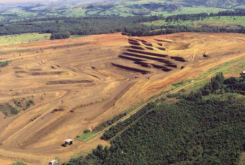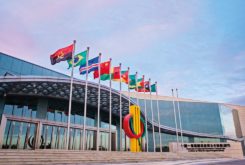Angola experienced its fourth straight year of recession in 2019. The government and the International Monetary Fund expect the new year to be a turning point, towards a return to growth. With the economy still dependent on oil revenues, much will depend on the country’s capacity to stop a decrease in oil production, as well as on oil prices in international markets.
In its latest evaluation of the Angolan economy, the IMF points to a deteriorating economic scenario expecting the economy to fall by 1.1% in 2019, due to a further decrease in the oil economy (-5.0%), not compensated by the largely stagnant non-oil economy (+0.6%).
For 2020, the IMF has also lowered its forecast, now expecting a 1.2% growth of the economy supported by a 1.3% increase in oil GDP and a 1.1% growth in non-oil GDP.
While the government anticipates a 1.8% increase in GDP, due to a 1.5% growth in the oil economy, the Economist Intelligence Unit forecasts a downturn in 2020 (-1.3%, recently revised upwards by 60 basis points), following a 3.3% drop in 2019 (also an improvement, of 30 basis points).
According to Angola’s National Statistics Institute (INE), the economic climate worsened again in the third quarter of 2019 to -7 points, 2 points below the previous quarter.
Construction and Retail (the most significant sectors in non-oil GDP) declined by 5 and 12 points, respectively. Apart from the improvements in Tourism (up 5 points) and Manufacturing (up 4 points), all sectors declined.
Despite efforts to diversify the economy, GDP, exports and government income mostly rely on oil.
For 2020, the government forecasts oil production to rise to 1.44 million barrels per day (mbd) from 1.39 mbd in 2019, which is optimistic according to most available projections, due to the natural rate of decline in mature projects.
The budget tempers this somewhat by basing its calculations on an average of US$55 per barrel of oil, in line with the long-term anchor price forecasted for Brent. Current prices are nearly US$70 and, while expected to drop in 2020, all major forecasts still put the Brent international average between US$60 and US$65.
If current production levels hold, along with prices, the government could again reach higher-than-expected oil tax revenues, and even a positive budget balance.
The government currently expects a budget surplus at 1.2% of GDP in 2020, which could be even higher, depending on how the oil industry performs.
A net funding of AOA 122 billion (US$253 million), together with budget savings (AOA 519 billion; US$1.08 billion) will amount to AOA 641 billion (US$1.33 billion) net increase in government assets, including deposits, acquisition cost of holdings, other capital transfers and the payment of commercial debt to Sonangol.
According to the last Eurobond prospectus, on 31 December 2018, there was an amount of US$15.7 billion available for disbursement, in financing lines already in use by the Angolan state. The amount budgeted for investment (about US$2.4 billion) should be funded by amounts of these lines, and a further US$4.4 billion could be partly financed by a new Eurobond in 2020 and other multilateral, bilateral or commercial bank financing.
In an effort to boost the non-oil economy, the government is implementing an import-substitution programme (PRODESI), aimed at creating productive clusters with a potential for internationalisation. As of December, more than 15,000 producers were registered for the programme, which covers 54 basic basket goods.
The programme’s progress was recently evaluated by Angolan bank BFA, which concluded that slightly less than half of the planned actions were fully implemented, with a little more than half of the rest partially implemented, and some intermediate steps already completed.
For example, in order to improve the business environment, the government aimed to improve property registries, by publishing official statistics on the number of transactions in the Notary Office, but the May 2019 deadline was not met.
However, several steps were taken to complete it, according to information provided to BFA by the government, including the implementation of the electronic protocol designed by the Ministry of Economy and Planning for the monitoring and control of the issuance of building certificates and the statistical analysis of the percentage of digitised registrations started.
On the other hand, there is a significant share of measures, a little over one quarter of the total, for which there is no (public) evidence of implementation. According to BFA, some actions have been taken in those regards. However, the lack of information disclosed so far regarding these particular measures, and the progress of the programme more generally, testifies to a lack of accountability and public communication of the process.
“From our assessment, the implementation of the programme is being slower than expected. These delays are particularly relevant if we consider that the nature of the measures will take time to pay off; it should be noted that, on the government’s side, there seems to be a political will to implement the programme; however, its reliance on the actions of many different institutions, together with budgetary constraints, may be conditioning its timely completion,” says BFA’s research department.
“We still think it would be necessary to present revised targets for several of the objectives, adapted to the reality of what can be achieved, and more importantly, of what needs to be achieved,” it adds.
The highest completion rates are seen in the business environment initiatives, private investment stimulus, and promotion of public-private partnerships. On the other hand, crosscutting initiatives related to physical and digital infrastructure, as well as training and qualification of human resources, have made the least progress. In particular, progress has been faster in measures mostly related to legislation, rules and initial programme structuring.
The measures still awaiting implementation are mainly linked to the construction or improvement of physical or digital infrastructures. As an example, the government is yet to achieve a significant cost reduction of electricity grid connection work, according to BFA’s evaluation.
PRODESI is supported by a credit line (PAC) of AOA 141 billion (US$292.4 million), expected to run from 2019 to 2022, with support of eight retail banks: BAI, BFA and BIC (AOA 30 billion each); Standard Bank Angola (AOA 20 billion); Millennium Atlântico (AOA 15 billion); BNI and BCH (AOA 6 billion each); and BCI (AOA 4 billion).




